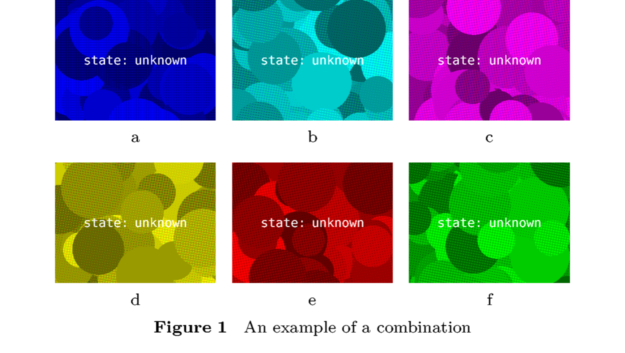Difference between revisions of "Combinations"
m (Text replacement - "</cmd>" to "}}") |
(Update code syntax) |
||
| Line 2: | Line 2: | ||
<texcode> | <texcode> | ||
| − | \startcombination[x*y] | + | \startcombination[x*y] %% x=columns, y=rows |
{something}{caption} ... | {something}{caption} ... | ||
... | ... | ||
\stopcombination | \stopcombination | ||
</texcode> | </texcode> | ||
| + | |||
| + | or using the newer interface: | ||
| + | |||
| + | <texcode> | ||
| + | \startcombination [nx=3, ny=2] %% 3 columns, 2 rows | ||
| + | \startcontent something \stopcontent | ||
| + | \startcaption caption \stopcaption | ||
| + | \startcontent something \stopcontent | ||
| + | \startcaption caption \stopcaption | ||
| + | \startcontent something \stopcontent | ||
| + | \startcaption caption \stopcaption | ||
| + | \startcontent something \stopcontent | ||
| + | \startcaption caption \stopcaption | ||
| + | \startcontent something \stopcontent | ||
| + | \startcaption caption \stopcaption | ||
| + | \startcontent something \stopcontent | ||
| + | \startcaption caption \stopcaption | ||
| + | \stopcombination | ||
| + | |||
| + | </texcode> | ||
| + | |||
means: | means: | ||
| Line 16: | Line 37: | ||
<context source=yes> | <context source=yes> | ||
| − | \ | + | \useMPlibrary [dum] %% sample images |
| − | [ | + | |
| − | [ | + | \startplacefigure [title=An example of a combination] |
| − | + | \startcombination [nx=3, ny=2] | |
| − | + | \startcontent \externalfigure [dummy] \stopcontent | |
| − | \startcombination[3 | + | \startcaption a \stopcaption |
| − | + | \startcontent \externalfigure [dummy] \stopcontent | |
| − | + | \startcaption b \stopcaption | |
| − | + | \startcontent \externalfigure [dummy] \stopcontent | |
| − | \stopcombination | + | \startcaption c \stopcaption |
| − | + | \startcontent \externalfigure [dummy] \stopcontent | |
| + | \startcaption d \stopcaption | ||
| + | \startcontent \externalfigure [dummy] \stopcontent | ||
| + | \startcaption e \stopcaption | ||
| + | \startcontent \externalfigure [dummy] \stopcontent | ||
| + | \startcaption f \stopcaption | ||
| + | \stopcombination | ||
| + | \stopplacefigure | ||
</context> | </context> | ||
| Line 45: | Line 73: | ||
This would produce something like 'figure 2.4d'. The content of the second parameter simply gets appended to the end of the figure's reference-number, thus the example above would still work even if the caption would be 'd) An awesome subfigure'. | This would produce something like 'figure 2.4d'. The content of the second parameter simply gets appended to the end of the figure's reference-number, thus the example above would still work even if the caption would be 'd) An awesome subfigure'. | ||
| + | == See also == | ||
| + | [[Floating_Objects#Subfloats]], {{cmd|startfloatcombination}}, {{cmd|startsubfloatnumbering}} | ||
[[Category:Graphics]] | [[Category:Graphics]] | ||
Revision as of 15:05, 28 November 2021
Combinations are ConTeXt's way to align several pictures (preferrably at same size):
\startcombination[x*y] %% x=columns, y=rows {something}{caption} ... ... \stopcombination
or using the newer interface:
\startcombination [nx=3, ny=2] %% 3 columns, 2 rows \startcontent something \stopcontent \startcaption caption \stopcaption \startcontent something \stopcontent \startcaption caption \stopcaption \startcontent something \stopcontent \startcaption caption \stopcaption \startcontent something \stopcontent \startcaption caption \stopcaption \startcontent something \stopcontent \startcaption caption \stopcaption \startcontent something \stopcontent \startcaption caption \stopcaption \stopcombination
means:
You define, how much figures in columns * rows you'd like to align.
You must provide one "figure something" (e.g. an \externalfigure) and a caption for every "cell".
The sample, from the manual, shows how to define a caption for the whole group and use it as float (see Floating Objects):
\useMPlibrary [dum] %% sample images \startplacefigure [title=An example of a combination] \startcombination [nx=3, ny=2] \startcontent \externalfigure [dummy] \stopcontent \startcaption a \stopcaption \startcontent \externalfigure [dummy] \stopcontent \startcaption b \stopcaption \startcontent \externalfigure [dummy] \stopcontent \startcaption c \stopcaption \startcontent \externalfigure [dummy] \stopcontent \startcaption d \stopcaption \startcontent \externalfigure [dummy] \stopcontent \startcaption e \stopcaption \startcontent \externalfigure [dummy] \stopcontent \startcaption f \stopcaption \stopcombination \stopplacefigure

Setup
There is \setupcombinations command.
Referencing
To reference a subfigure you can provide the subfigure's caption as a second parameter to the \in command.
To reference the subfigure with the caption d you would write:
\in{figure}{d}[fig:combinations]
This would produce something like 'figure 2.4d'. The content of the second parameter simply gets appended to the end of the figure's reference-number, thus the example above would still work even if the caption would be 'd) An awesome subfigure'.
See also
Floating_Objects#Subfloats, \startfloatcombination, \startsubfloatnumbering